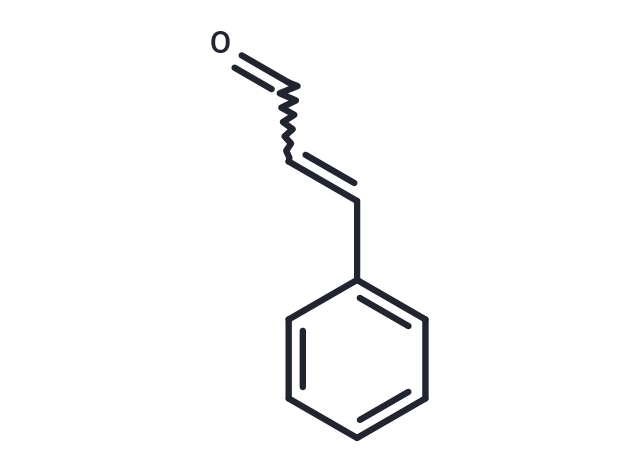- Remove All
 Your shopping cart is currently empty
Your shopping cart is currently empty
Cinnamaldehyde
1. Cinnamaldehyde (Cinnamic Aldehyde) has antipyretic activity. 2. Cinnamaldehyde is a sedative agent. 3. Cinnamaldehyde inhibits invasive capabilities of MDA-MB-435S cells was correlated with down-regulating the expression of miR-27a. 4. Cinnamaldehyde induces the generation of reactive oxygen species and exerts vasodilator and anticancer effects. 5. Cinnamaldehyde appears to be a promising candidate as an adjuvant in combination therapy with 5-fluorouracil (5-FU) and oxaliplatin (OXA), two chemotherapeutic agents used in CRC treatment. The possible mechanisms of its action may involve the regulation of drugmetabolizing genes. 6. Cinnamaldehyde plays a certain role in inhibiting the occurrence and progression of melanoma and its action mechanism may be manifested by inhibiting expression of VEGF and HIF-α, thus blood vessel simulation and formation of new blood vessels of melanoma cells, and growth of tumors accordingly.

Cinnamaldehyde
| Pack Size | Price | Availability | Quantity |
|---|---|---|---|
| 100 mg | $30 | In Stock | |
| 500 mg | $64 | In Stock | |
| 1 g | $93 | In Stock | |
| 1 mL x 10 mM (in DMSO) | $39 | In Stock |
Product Introduction
| Description | 1. Cinnamaldehyde (Cinnamic Aldehyde) has antipyretic activity. 2. Cinnamaldehyde is a sedative agent. 3. Cinnamaldehyde inhibits invasive capabilities of MDA-MB-435S cells was correlated with down-regulating the expression of miR-27a. 4. Cinnamaldehyde induces the generation of reactive oxygen species and exerts vasodilator and anticancer effects. 5. Cinnamaldehyde appears to be a promising candidate as an adjuvant in combination therapy with 5-fluorouracil (5-FU) and oxaliplatin (OXA), two chemotherapeutic agents used in CRC treatment. The possible mechanisms of its action may involve the regulation of drugmetabolizing genes. 6. Cinnamaldehyde plays a certain role in inhibiting the occurrence and progression of melanoma and its action mechanism may be manifested by inhibiting expression of VEGF and HIF-α, thus blood vessel simulation and formation of new blood vessels of melanoma cells, and growth of tumors accordingly. |
| Alias | Cinnamic Aldehyde |
| Molecular Weight | 132.16 |
| Formula | C9H8O |
| Cas No. | 104-55-2 |
| Smiles | O=CC=Cc1ccccc1 |
| Relative Density. | 1.05 g/cm3 at 25℃ (lit.) |
| Storage | Powder: -20°C for 3 years | In solvent: -80°C for 1 year | Shipping with blue ice. | |||||||||||||||||||||||||||||||||||
| Solubility Information | DMSO: 45 mg/mL (340.49 mM) | |||||||||||||||||||||||||||||||||||
Solution Preparation Table | ||||||||||||||||||||||||||||||||||||
DMSO
| ||||||||||||||||||||||||||||||||||||
Calculator
In Vivo Formulation Calculator (Clear solution)
Dose Conversion
Tech Support
Keywords

Copyright © 2015-2024 TargetMol Chemicals Inc. All Rights Reserved.



